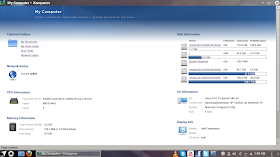Somehow I was never very comfortable with so called "lightweight" distros primarily because of the very limited functionalities they offer. I have tried out Slitaz, Puppy Linux, MacPup, etc. to name a few and finally settled for Openbox distros like Manjaro openbox, Archbang, Crunchbang, Sparkylinux, etc. In between, I tried e17 distros like Bodhi and Snowlinux as well. Actually all these were for a HP Pentium-IV PC with 1.5 GB RAM that I have. On that system, on conventional DEs like LXDE/XFCE, I face issues while watching movies and playing online videos in YouTube - things tend to drag a lot! Right now it has Manjaro Openbox Lite which works fantastic on it. Alongside, I was also looking for a system with more conventional DE and antiX's name popped into my mind while browsing through Distrowatch top 100 list.
Before directly jumping on to my tests and results, a brief intro of antiX. AntiX is a Debian based distro with both 32 and 64 bit releases. It primarily bases it's repo on Debian testing though stable (Debian wheezy) is also available. antiX offers users it's own customized desktop environment "antiX magic" suitable for old computers. It claims to run well even on PII/PIII systems with 128 MB RAM. The latest release of antiX is 13.1, based on Debian Wheezy. It's release note states:
 |
| From antiX 13.1 http://mylinuxexplore.blogspot.in |
"The antiX team is pleased to announce the first update of antiX 13 (code name 'Luddite'), based on Debian 'Wheezy'. This update includes those made upstream in Debian 'Wheezy' and various bug fixes specific to antiX: 64-bit kernel recompiled so non-free drivers will build in 'Wheezy'; 64-bit alert message when booting 32-bit ISO image fixed; 'ghost' window fix in IceWM; GUI installer should write correct GRUB entries for any other installed OS; GUI installer should set correct keyboard; more options to enable and disable services at boot; added cdw and Calcurse to IceWM menu; fixed missing icons from IceWM menu; Gufw firewall configuration fixed...."I downloaded the 32-bit full ISO, about 675 MB in size, not a typical of lightweight distro, I must say. I created a live USB from it, using Unetbootin. For live boot and installation, I used a couple of systems:
- HP Pentium IV 2.2 Ghz single core personal computer with 1.5 GB DDR RAM and 512 kb Intel graphics (from 2003, used to be state of the art then!)
- Asus K54C laptop with Core-i3 2.2 Ghz processor and 2 GB RAM



